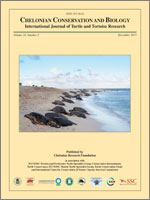The present study is the first to characterize Kemp’s ridley turtle (Lepidochelys kempii) diets between the west-central Florida estuaries of Tampa Bay to Charlotte Harbor. We analyzed the stomach contents of 20 stranded subadult L. kempii and found that their diets were primarily carnivorous, consisting mostly of calico crab (Hepatus epheliticus), stone crab (Menippe mercenaria), and blue crab (Callinectes sapidus). In addition, we found uncommon prey items including fish and horseshoe crab (Limulus polyphemus), suggesting these L. kempii are opportunistic feeders. When separated into 2 size classes (25–45 [n = 9] and > 45 [n = 11] cm straight carapace length), there was a significant difference in the turtles’ diet composition. These new insights into the ecology and life history of a critically endangered sea turtle reveal essential prey resources used by a poorly studied yet crucial subadult life stage.
How to translate text using browser tools
1 December 2015
Diet Analysis of Subadult Kemp’s Ridley (Lepidochelys kempii) Turtles from West-Central Florida
Jennifer A. Servis,
Gretchen Lovewell,
Anton D. Tucker
ACCESS THE FULL ARTICLE
HAB
Harmful Algal Bloom
Red Tide
Reptilia
Testudines





